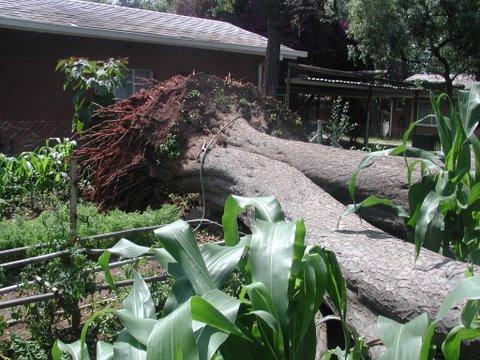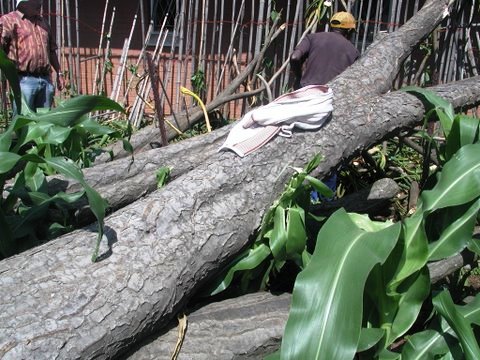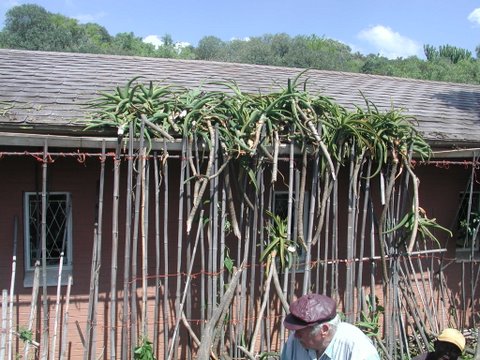On the 20th of November big rains softened the ground on which an enormous Aloe barberae stood at the edge of a vegetable garden on a scenic smallholding in North Riding, not far from The Dome, a landmark big event venue in Randburg. In fact, three huge specimens of this majestic plant, king of the aloes, towered over the surroundings of garden, house and outbuildings. They had been planted there well over twenty years ago by the owner, Dries Neethling, a retired builder, indigenous gardener, past chairman of Operation Wildflower and maybe not so retired plant lover and small scale farmer.

Three elephant sized Aloe barberae
A big tree used to grow immediately next to the aloe that fell on that Friday (the 20th, not the 13th). This tree had caused the aloe to grow slightly to one side, so that the aloe hung slightly skew after the tree had been removed some time before. The deviation from the perpendicular, much rain, cultivated vegetable garden soil and probably some wind, all contributed to bring down the aloe, a beast of specimen, probably over 12, maybe 14 metres in height. It fell across the maize, spinach and other vegetables in the neat garden, hitting the roof edge and reed hedge on the opposite side, so that a curtain of aloe pieces, several of them more than 2 metres in length, was still hanging from the wall by the next Monday.
A couple of Operation Wildflower members were invited urgently to help remove the wrecked plant in manageable installments from the site for the vegetable crop (and some aloe) to be saved. The higher branches and some leaf rosettes had already broken off during the fall or could easily be sawn off. The thicker branches took more effort and care to prevent injury to the workers through secondary accidents: pieces thicker than 30 cm and cut in longer than meter lengths easily exceeded 200 kg, requiring two strong men for carrying. And that was just over halfway down to the big end where the root base was over two metres in diameter!
Without any opportunity for measurements, the estimated mass of the plant was around 20 tonnes or thereabouts! That equals three big elephants in body mass. To see such an aloe go down is an event of comparable sadness just like seeing a big elephant go. Sadder, because it is the size of three elephants; not so sad because of the possibility of plant saving. Most of the pieces are planted and grow again in hundreds of new plants. Close to the dropped down aloe seedlings of the same species were growing already. But most Aloe barberae propagation today occurs from cuttings.

Aloe Trunk in the Mielies (Corn)
Sawing the broken ends neatly, applying some tree seal and planting them after a few weeks for allowing the wounds to dry out and prevent rotting in the ground will do the trick. Watering requirements for this aloe are not excessive, but it does not complain easily about variations in living conditions. Sunlight is important, although partial sunlight among open woodland shrubs and trees would reconstruct Aloe barberae’s natural surroundings in the Eastern Cape, Kwazulu-Natal and Swaziland. The soil type is probably not critical either as these plants can thrive on clay soils inland as well as on quite sandy coastal land.
Aloe barberae used to be called A. bainesii, as many aloe aficionados may still know this popular tree aloe and garden plant. (The oldest formal description found in the available literature is always chosen when several written accounts exist, so that ‘barberae’ was retained in this case.) The comparative ease with which one can grow this aloe and its high disease resistance are, however, not its main attractions: gardeners love A. barberae because of the elegant, smooth stem lines and leaf curvature in the rosettes. The flowers are salmon pink to orange, but comparatively small and less spectacular than in many other aloe species, causing the graceful leaf shape to be the deciding consideration for choosing it for the garden.
Young plants and transplanted truncheons with single or multiple leaf rosettes usually have big leaves, often over a metre long. As the plant gets taller, branching occurs in most rosettes to create a spreading crown, gradually reducing the leaf size as more of them must compete for a share of the available nutrients. Leaves tend to curve back more as the tree gets older and may also get a reddish colour as opposed to the dark green often found in robust young plants. There are only small teeth on the leaf edges, making the handling much easier and less painful than for instance in the case of Aloe marlothii.

Branches hanging from the wall where the falling aloe hit the roof
Does a story like this require a moral? Maybe only that one should think carefully about where to plant Aloe barberae, so that it does not drop through the roof and land in your bed on a stormy night!

